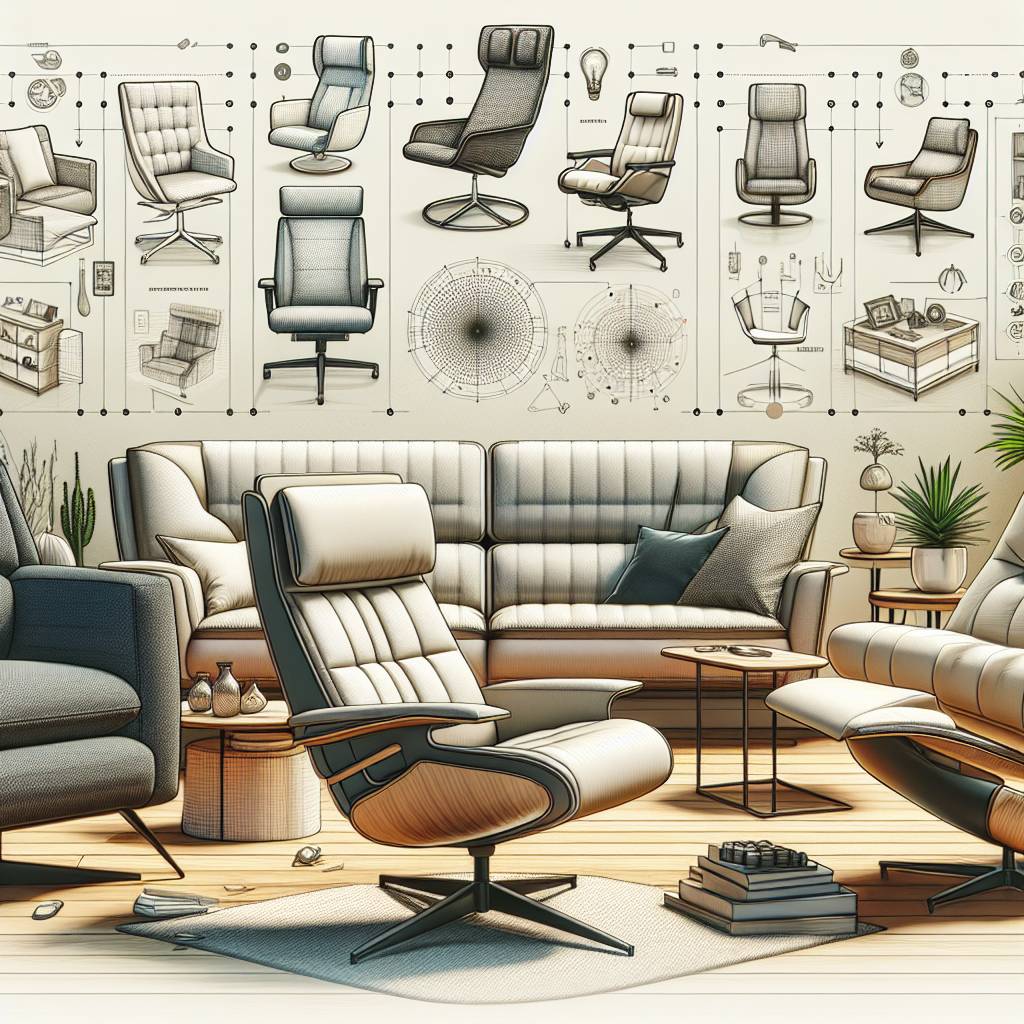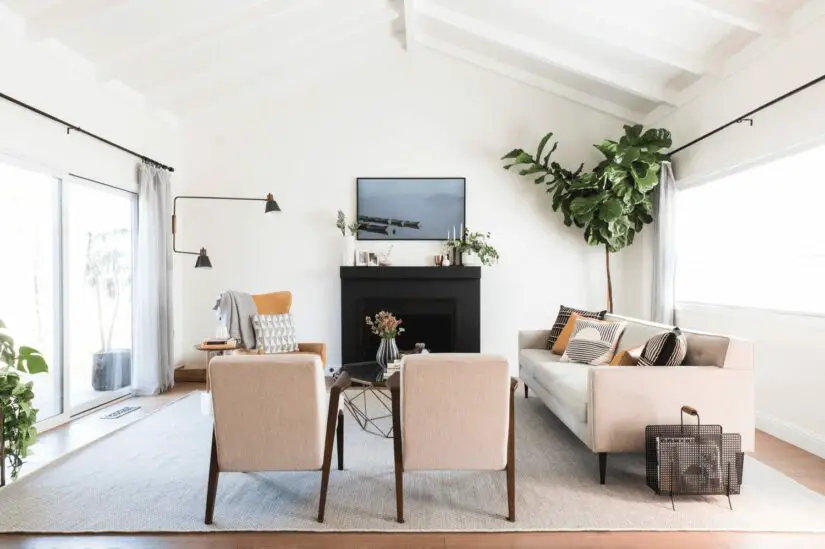Ergonomic seating isn’t just a buzzword; it’s a revolution that has transformed our living rooms into havens of comfort and functionality. Once upon a time, chairs were mere objects to sit on, but today’s ergonomic seating solutions are meticulously designed to support the contours of the human body, turning lounging into an art form. As we delve into the world of ergonomic furniture, we uncover how these pieces aren’t just stylish additions but are pivotal in enhancing everyday life by offering unparalleled comfort tailored to your posture and preferences.
The seamless blend of ergonomics in living spaces is more than a trend—it’s about fostering an environment where relaxation meets health benefits. From plush recliners that adjust to your body’s needs to sofas that provide lumbar support without compromising on style, modern homes are now sanctuaries equipped with seating designed for long-lasting well-being.
The Importance of Ergonomic Furniture for Comfort and Health
Improved Posture
Ergonomic seating solutions for living rooms play a crucial role in enhancing posture. Properly designed furniture encourages the body to maintain its natural curves, supporting the spine’s alignment. This reduces strain on the neck, shoulders, and back muscles. For example, chairs with lumbar support can help individuals sit upright without slouching or hunching over.
Ergonomic furniture also promotes better sitting habits by encouraging individuals to sit with their feet flat on the floor and knees at a 90-degree angle. This helps distribute weight more evenly across the body, preventing discomfort and fatigue. By maintaining good posture while seated, individuals are less likely to experience muscle tension or stiffness after prolonged periods of sitting.
Alleviating Discomfort
The impact of ergonomic seating on alleviating back pain and other discomforts is significant. Chairs with adjustable features, such as height-adjustable armrests and reclining capabilities, allow users to customize their seating position based on their comfort needs. These adjustments can relieve pressure points and reduce muscle tension that often leads to discomfort during extended periods of sitting.
Moreover, ergonomic seating solutions incorporate materials that provide adequate cushioning while offering firm support where needed most. This combination ensures that individuals do not sink too deeply into the seat nor feel like they are perched uncomfortably atop it. As a result, ergonomic furniture minimizes pressure on sensitive areas like the tailbone while providing proper support for long-term comfort.
Promoting Overall Health
Durability is an essential aspect when considering ergonomic furniture’s role in promoting overall health. High-quality materials ensure that ergonomically designed chairs maintain their supportive features over time without succumbing to wear and tear quickly. Durable construction allows these pieces of furniture to withstand regular use without compromising their ability to provide optimal comfort and support.
In addition to physical well-being, ergonomic seating contributes significantly to mental health by creating comfortable living spaces where relaxation is encouraged rather than hindered by discomfort or poor posture habits.
Ergonomic Living Room Furniture Placement for Optimal Use
Significance of Strategic Furniture Placement
Strategic placement of furniture is crucial in ensuring ergonomic seating solutions for modern living rooms. By positioning sofas, chairs, and tables thoughtfully, it becomes possible to create a space that promotes comfort and supports the body’s natural posture. This not only enhances the visual appeal of the living room but also contributes significantly to overall well-being. For instance, placing a supportive chair near a reading lamp creates an inviting nook for relaxation and leisure activities.
Optimizing ergonomic seating through strategic furniture placement can greatly impact how individuals interact with their living spaces. Placing the sofa facing the television or fireplace allows for comfortable viewing or conversation areas within the room. Arranging furniture to facilitate easy movement throughout the space ensures that every corner of the living room remains accessible and functional.
How Room Layout Affects Ergonomic Seating
The layout of a modern living room plays a pivotal role in determining how effectively ergonomic seating solutions can be implemented. An open floor plan provides ample opportunities to experiment with various furniture arrangements while maintaining flow and functionality. On the other hand, smaller or more enclosed spaces may require careful consideration when positioning pieces to avoid creating cramped or obstructed pathways.
When considering positioning, it’s essential to take into account factors such as natural light sources, architectural features like windows and doors, as well as traffic patterns within the room. For example, placing an armchair by a window allows individuals to enjoy natural light while engaging in activities like reading or crafting without straining their eyes unnecessarily.
Taking these points into consideration will help homeowners make informed decisions when arranging their living rooms’ furniture layouts:
- Position sofas perpendicular rather than directly across from each other.
- Place coffee tables at arm’s length from surrounding seats.
- Consider leaving adequate clearance around each piece of furniture for ease of movement.
Selecting Comfortable Chairs for Your Living Space
Chair Adjustability
When selecting ergonomic seating solutions for living rooms, it’s crucial to consider the chair’s adjustability. This feature allows you to customize the chair according to your specific comfort needs. For instance, adjustable armrests and lumbar support can help maintain proper posture, reducing the risk of discomfort or pain.
Adjustable chairs ensure that individuals of varying heights and body types can find their optimal sitting position. This adaptability is especially important in shared living spaces where multiple people with different ergonomic requirements may use the same chair. By having customizable features, such as seat height and tilt tension, everyone can experience maximum comfort.
The ability to modify a chair’s settings also supports dynamic sitting, allowing users to change their positions throughout the day. This promotes better blood circulation and reduces strain on particular muscle groups, contributing to overall well-being.
Relationship Between Design and Body Mechanics
Another critical aspect when choosing an ergonomic seating solution is understanding how design influences body mechanics. The shape of a chair should complement the natural curves of the spine while providing ample support for areas prone to pressure points – like the lower back and hips.
For example, a durable living room chair with quality materials might offer both functionality and aesthetic appeal as part of home decorations while ensuring ultimate comfort for its users. Considering weight capacity is essential as it directly impacts user safety and long-term durability.
Moreover, incorporating pillows or throw pillows along with a soft area rug complements ergonomic chairs by adding extra cushioning support where needed without compromising style or visual appeal in your living space.
Stylish and Ergonomic Seating Solutions for Modern Homes
Trendy Designs
Ergonomic seating solutions for living rooms strike a perfect balance between stylish living room chairs and comfort. Today, modern design trends emphasize the fusion of form and function in furniture. For instance, the mid-century accent chair combines sleek lines with ergonomic support, making it an ideal choice for both style-conscious individuals and those who prioritize comfort.
The ottoman is another example of a stylish addition that offers more than meets the eye. It not only serves as a chic footrest but also provides additional seating when needed. This multifunctional piece complements the aesthetic appeal of a living room while contributing to its ergonomic layout.
Functional Furnishings
Sleek coffee tables are also becoming popular choices in modern homes due to their dual functionality – serving as both an elegant centerpiece and a practical surface for everyday use. These tables often feature smooth edges, ensuring safety without compromising on visual appeal.
Homeowners can now choose from various innovative seating solutions such as recliners with built-in lumbar support or armchairs designed to promote proper posture without sacrificing style.
Space-Saving Designs for Small and Multifunctional Living Areas
Overview of Compact Furniture Options
Compact furniture options are essential. Pieces like modular sofas, nesting tables, and ottomans with hidden storage compartments can maximize functionality without taking up too much space. These furniture items not only provide comfort but also offer practical storage solutions, making them ideal for small living areas.
Compact ergonomic seating solutions often come in versatile designs that serve multiple purposes. For instance, a sleeper sofa can be used as a comfortable seating area during the day and transformed into a bed at night. This dual functionality is especially beneficial for studio apartments or cozy areas where space is limited. Adjustable coffee tables that can be raised to dining table height offer flexibility without compromising on style or comfort.
Multifunctional furniture pieces such as wall-mounted desks or foldable chairs are perfect examples of how innovative design can optimize space while maintaining ergonomics. These items can be easily tucked away when not in use, allowing the living area to serve different purposes throughout the day.
Benefits of Multifunctional Furniture
The utilization of multifunctional furniture in small living spaces brings several benefits beyond just saving space. It allows individuals to create a dynamic environment that adapts to their changing needs throughout the day. For example, a convertible sofa with built-in storage provides an efficient way to keep the living room organized while offering extra sleeping arrangements when needed.
Furthermore, incorporating multifunctional pieces into home design enables individuals to make the most out of their available square footage without sacrificing comfort or style. By choosing ergonomic seating solutions that double as storage units or additional sleeping areas, homeowners can maintain an uncluttered and inviting atmosphere even in smaller homes.
Creative Ways to Optimize Space Without Compromising on Ergonomics
In addition to selecting compact and multifunctional furniture options, there are creative ways to further optimize space within small living areas while prioritizing ergonomics:
- Utilize vertical space by installing wall-mounted shelves or hanging organizers.
- Incorporate furniture with sleek designs and clean lines that visually open up the room.
- Choose lightweight yet durable materials for easy rearrangement when needed.
- Embrace multipurpose decor elements like floor cushions that can function as extra seating when guests visit.
Versatile Seating Options for Diverse Living Room Activities
Importance of Versatile Seating
Versatile ergonomic seating solutions are essential for accommodating diverse activities in the living room, such as reading, watching TV, or socializing. A flexible seating arrangement allows individuals to easily transition from one activity to another without feeling constrained by their furniture. For instance, a comfortable armchair with an adjustable ottoman can seamlessly transform into a cozy reading nook and then adapt to provide additional seating when guests visit. This versatility ensures that the living room remains conducive to various needs and preferences.
Moreover, in a dynamic living room environment where different activities take place throughout the day, having versatile seating options is crucial for optimizing space and functionality. By incorporating modular sofas or sectional pieces with movable components, homeowners can effortlessly reconfigure their seating area based on specific requirements. This adaptability not only enhances comfort but also promotes efficient use of space in smaller or multifunctional living areas.
Examples of Ergonomic Solutions
One example of a versatile ergonomic seating solution suitable for different activities is a convertible sofa bed with adjustable backrests and built-in storage compartments. During the day, it serves as a stylish couch for lounging or entertaining guests; at night, it transforms into a comfortable bed for overnight visitors. Another great option is a recliner chair with integrated cup holders and USB charging ports—ideal for creating an inviting entertainment zone within the living room while offering convenient amenities.
In addition to traditional furniture pieces like sofas and armchairs, innovative designs such as floor chairs with adjustable back support cater to individuals who prefer relaxed sitting positions while engaging in activities like gaming or meditation. These lightweight alternatives can be easily moved around the living room to accommodate various setups based on personal preferences.
Features of Ergonomic Chairs for Enhanced Back Support
Lumbar Support
Ergonomic seating solutions for living rooms offer lumbar support to help maintain the natural curve of the spine. This feature is crucial in preventing back pain, as it provides support to the lower back, reducing strain and promoting proper posture. The lumbar region is particularly vulnerable to discomfort when seated for extended periods, so this targeted support can make a significant difference in overall comfort.
The adjustable lumbar support feature allows users to customize the level of support based on their unique needs. By providing adequate reinforcement for the natural curvature of the spine, ergonomic chairs effectively alleviate pressure on the lower back muscles and discs. For instance, models with inflatable lumbar cushions enable individuals to tailor the level of firmness according to their preference, ensuring optimal comfort and spinal alignment.
Seat Depth and Backrest Angle
Another essential aspect of ergonomic seating solutions is seat depth and backrest angle. These features contribute significantly to overall comfort by accommodating various body types while promoting healthy sitting postures. Optimal seat depth ensures that there’s sufficient space between the edge of the chair and one’s knees when seated comfortably against its backrest.
Moreover, an adjustable backrest angle enables users to recline or sit upright as needed, supporting different activities such as reading or watching television in a living room setting. A dynamic range of motion in terms of adjusting these angles ensures that individuals can find their most comfortable positions without straining their backs or compromising proper spinal alignment.
Tips for Designing an Ergonomic and Stress-Free Living Room
Lighting Matters
Proper lighting is essential in a living room. It can reduce eye strain and create a calming atmosphere. Use multiple light sources to control the brightness. For example, combine overhead lights with floor lamps or wall sconces.
Natural light is best for daytime use. Open curtains wide during the day to let sunlight in. This will not only brighten up the space but also provide vitamin D.
Color Schemes
Colors influence mood significantly. Choose colors that make you feel relaxed and at ease. Soft blues, greens, and neutrals are known to have calming effects on the mind.
Avoid overly vibrant colors as they may be stimulating rather than relaxing. If you love bold colors, introduce them through accessories like cushions or art pieces instead of wall paint.
Declutter Regularly
A clutter-free environment promotes peace of mind and relaxation. Keep your living room tidy by regularly decluttering it.
- Remove items that don’t belong in the living room.
- Use storage solutions like baskets or cabinets to organize essentials.
This way, you maintain both ergonomics and aesthetics without sacrificing comfort.
Personal Touches
Your personal preferences play a big role in creating an ergonomic space that suits your needs.
Incorporate elements that reflect your style while keeping ergonomics in mind.
For instance:
- Select ergonomic seating solutions tailored to your body size and shape for maximum comfort.
- Place family photos around to foster warmth and personal connection within the space.
Remember, designer advice often emphasizes individuality alongside functionality when designing spaces for well-being.
Living Room Furniture Buying Guide Focused on Ergonomics
Comfort First
When considering ergonomic seating solutions for living rooms, comfort should be the top priority. Look for furniture with ample cushioning and proper support for your back, neck, and legs. A comfortable seat will encourage relaxation and reduce the risk of discomfort or pain during prolonged sitting.
Furniture that offers adjustable features such as reclining options or customizable headrests can provide a personalized level of comfort. For example, a recliner with an adjustable footrest allows you to find the most comfortable position based on your preferences.
Supportive Design
Opt for furniture with a supportive design that promotes good posture. Look for chairs and sofas with lumbar support to maintain the natural curve of your lower back. This feature helps prevent slouching and minimizes strain on your spine.
Consider pieces with adequate armrests at the correct height to support your arms while seated. Properly positioned armrests can help reduce tension in your shoulders and upper body muscles, enhancing overall comfort when using the furniture.
Test Sitting
Before making a purchase, it’s crucial to physically test out different ergonomic seating solutions in person. Visit furniture stores or showrooms where you can sit in various chairs and sofas to assess their comfort levels firsthand.
Take note of how each piece feels when you sit down; pay attention to whether it adequately supports your body and provides the desired level of comfort. Testing out furniture before buying ensures that you select pieces best suited to your specific ergonomic needs.
Movement Assessment
While testing seating options, take some time to evaluate how easy it is to adjust positions while seated on different pieces of furniture. Consider how smoothly recliners operate or if sofas offer enough space for shifting positions comfortably.
Material Quality
When purchasing ergonomic living room furniture, prioritize high-quality materials known for durability and longevity. Look for sturdy frames made from hardwood or metal which ensure stability over time.
Quality upholstery fabrics like leather or tightly woven textiles are more resistant to wear compared to cheaper alternatives like faux leather or loosely woven fabrics.
Conclusion
Ergonomic seating is more than just a buzzword for your living room—it’s a game-changer for your comfort and health. We’ve walked through the essentials, from selecting cozy chairs to arranging them for maximum benefit. Think of your space as a wellness hub; every piece of furniture plays a role in supporting your back and boosting your well-being. Whether you’re curling up with a good book or hosting a movie marathon, ergonomic solutions ensure you’re sitting pretty without the ache.
Ready to transform your living room into an oasis of comfort? Dive into the world of ergonomic furniture. Pick pieces that speak to you and your lifestyle, keeping both style and function in mind. Don’t just take our word for it—try it out! Your back (and your future self) will thank you. Let’s make slouching on the sofa ancient history. Start shopping smart for that perfect ergonomic throne today!
Frequently Asked Questions
What is ergonomic seating and why is it important for my living room?
Ergonomic seating supports your body comfortably, reducing strain and enhancing posture. It’s vital for preventing aches during relaxation at home.
How do I choose an ergonomic chair for my living space?
Look for chairs with adjustable features, lumbar support, and materials that suit your comfort preferences. Test them out if possible!
Can ergonomic furniture be stylish too?
Absolutely! Modern designs offer both style and ergonomics, ensuring you don’t sacrifice aesthetics for comfort in your living room.
Are there space-saving ergonomic solutions for small living areas?
Yes, many brands offer sleek, multifunctional pieces perfect for tight spaces without compromising on ergonomics or style.
What should I consider when placing my ergonomic furniture in the living room?
Focus on creating a layout that allows easy movement while positioning seats to face focal points like TVs or fireplaces at eye level.
How can seating options cater to different activities in my living room?
Versatile seating like recliners or modular sofas can adapt to various activities such as reading, socializing, or lounging effectively.
What features do I look for in chairs to enhance back support?
Prioritize chairs with adjustable lumbar support, headrests and those that encourage a natural sitting position to protect your back.






